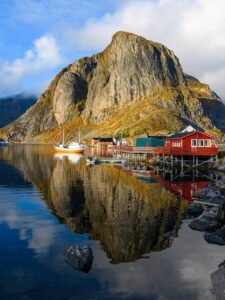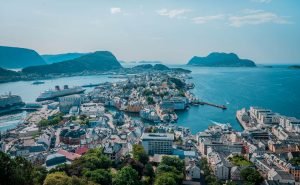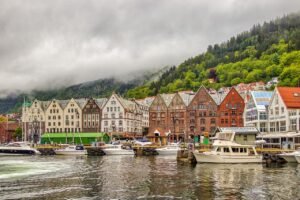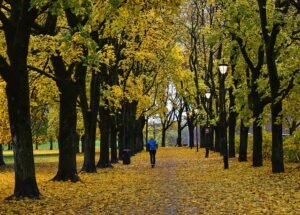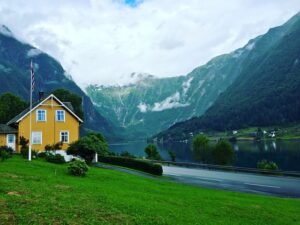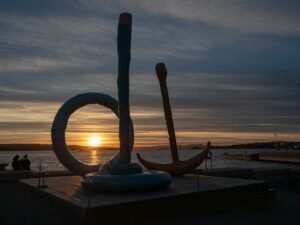

Cultural Treasures of Norway: Museums, Historic Sites, and Local Traditions
What makes Norway’s cultural landmarks stand out on the global stage, earning them UNESCO World Heritage status?
Norway, a country with a rich historical impact spanning across Europe, boasts an array of cultural treasures deeply rooted in the Viking Age. From the iconic wooden stave churches to ancient Viking villages, the Scandinavian cultural heritage is meticulously preserved in many natural and cultural sites. Museums in Norway, such as Bryggens Museum in Bergen, unveil a stunning array of historic attractions that capture the essence of its past. Did you know that only 28 stave churches, including the renowned Urnes Stave Church, survive today out of the estimated 1,000 to 2,000 that existed during medieval times?
Among more than 1,000 World Heritage Sites globally, Norway features eight distinguished landmarks and areas on UNESCO’s list, representing the most significant natural and cultural landscapes. For instance, the Geirangerfjord and Nærøyfjord were acknowledged by UNESCO in 2005 solely based on their stunning natural beauty. Norway’s landscape, dotted with museums and historic sites, offers myriad experiences from viewing ancient Viking ships in the Viking Ship Museum in Oslo to participating in seasonal festivals in the Lofoten Islands.
Whether exploring the complex history through traditional crafts and living practices or absorbing the serene beauty of Norway’s fjords and stave churches, you will find a testament to Norway’s rich heritage nearly everywhere you turn. Norway’s cultural heritage sites and scenic beauty present an unparalleled journey into the past, making it a compelling destination for history buffs and curious travelers alike.
Table of Contents
ToggleIntroduction to Norwegian Heritage
Norwegian heritage is deeply rooted in the history of Europe, weaving a rich tapestry that spans centuries. This heritage is celebrated across the continent, particularly highlighted by the Viking influence that extended to cities like Dublin, showcasing a time when Norwegian Vikings played a pivotal role in regional developments. This historical significance is preserved throughout Norway’s landscapes, meticulously maintained museums, and the safeguarding of ancient sites.
Historical Influence Across Europe
Norway’s impact on European historical landmarks is profound. The conversion from Norse mythology to Christianity around the year 1000 marked a significant cultural shift, symbolized by the country’s 28 remarkable stave churches. These stunning structures blend Christian and Norse elements, adorned with intricate rosemaling.
Norway’s historical influence is further exemplified by its pioneering gender equality values, being the fourth country globally to grant voting rights to women, and having one of the leading gender equality rankings worldwide. This commitment to equality is enshrined in Norwegian heritage and is evident in the country’s cultural experiences, from museums to local festivals.
Norway’s Rich Woven History
The diversity of cultural experiences in Norway is unparalleled. Spanning 3000 kilometers from its southern to northern extremes, Norway offers a wide range of culinary experiences, anchored in the use of local, sustainable food. Urban centers are home to 14 Michelin-starred restaurants, offering world-class dining.
Visitors can engage with Norwegian heritage through numerous outdoor activities. Iconic sites like Trolltunga, Preikestolen, and Gaustatoppen draw global visitors each year. Meanwhile, Northern Norway’s Aurora Borealis provides a spectacular natural display from October to April, adding to the country’s allure.
The preservation and showcasing of cultural landmarks in Norway are pivotal, with institutions like the Nidaros Cathedral in Trondheim, a renowned Gothic masterpiece marking the end of many pilgrim routes, and the Bryggen in Bergen, a UNESCO World Heritage Cultural site since 1979, standing as testaments to the country’s historical and cultural wealth.
Consider the annual celebration on the 17th of May, Norway’s national day, where the entire nation engages in parades, flag-waving, and jubilant festivities, encapsulating the very essence of Norwegian spirit and heritage.
Exploring Viking Heritage in Norway
Norway offers a treasure trove of Viking legacies, from preserved villages that stand in testament to the country’s past, to the revered stave churches that dot the landscape. Museums dedicated to Viking culture abound, with extensive collections that provide insight into the era’s way of life.
Preserved Viking Villages
One of the most immersive Viking villages is Viking Valley Njardarheimr in Gudvangen, which attracts numerous visitors eager to explore Viking heritage. Here, guests can get a taste of life as it was a millennium ago, with guided tours and markets highlighting Norwegian traditional crafts. Another notable site is the Avaldsnes Viking Farm on Bukkøy Island in Rogaland, Western Norway. This popular summer destination offers engaging activities and rich historical narratives.
Iconic Wooden Stave Churches
Interspersed among the natural landscape, Norway’s stave churches are architectural marvels. Stave churches in Norway, such as Heddal, Borgund, and the UNESCO World Heritage Urnes, serve as steady reminders of the country’s intricate blend of Christian and pagan traditions. These medieval churches feature elaborate wood carvings and stand as fascinating symbols of Viking heritage.
Countless Museums Dedicated to Viking Culture
A multitude of Viking culture museums provide a deeper dive into the lives of our Viking ancestors. The Viking Ship Museum in Oslo, located on the Bygdøy peninsula, is famous for housing three remarkably preserved ships: Oseberg, Tune, and Gokstad. Another gem, Kaupang Viking Town in Larvik, offers educational activities and a palpable sense of the first urban settlement from the Viking Age. The Lofotr Viking Museum in Lofoten preserves the remains of an extensive Viking building and explores the rich and influential heritage that characterized the era.
Below is a comparative glance at some Viking-centric destinations:
| Location | Main Attraction | Key Features |
|---|---|---|
| Njardarheimr, Gudvangen | Njardarheimr Village | Guided tours, markets, traditional crafts |
| Bygdøy, Oslo | Viking Ship Museum | Oseberg, Tune, Gokstad ships |
| Larvik | Kaupang Viking Town | Educational activities, urban Viking settlement |
| Bukkøy Island | Avaldsnes Viking Farm | Guided tours, summer activities |
| Lofoten | Lofotr Viking Museum | 83-meter Viking building, historical artifacts |
Historic Sites Around Bergen
Bergen, founded in 1070, has evolved into one of Norway’s most crucial cities, rich in history and culture. This city, often referred to as the gateway to the fjords, boasts numerous historic sites that narrate the vibrant stories of its past.
Bryggens Museum
The Bryggens Museum is a true gem among historic sites in Bergen. Located at the iconic Bryggen Wharf, a UNESCO World Heritage site, this museum houses artifacts that date back to the 14th century. Visitors can explore remnants from Bergen’s fire-stricken past and learn about the city’s reconstruction efforts, providing a unique glimpse into medieval merchant life.
Bergen Maritime Museum
The Bergen Maritime Museum delves deep into Norway’s seafaring history, a significant aspect of the Norwegian cultural treasures. Here, detailed exhibits showcase maritime artifacts, ship models, and historical narratives from the Viking Age to the modern era. This museum provides a comprehensive overview of how maritime activities have shaped Bergen’s development over centuries.
Hanseatic Museum in Bryggen
Located in the heart of Bryggen, the Hanseatic Museum highlights Bergen’s pivotal role in historical trade. The museum preserves the homes and workplaces of Hanseatic merchants, displaying their goods, tools, and living conditions. Through its exhibits, the Hanseatic Museum brings to life the bustling trade activities that once made Bergen Scandinavia’s largest town until the 1830s.
These Norwegian cultural treasures offer invaluable insights into Bergen’s storied past. The combination of the Bryggens Museum, the Bergen Maritime Museum, and the Hanseatic Museum stands as a testament to the city’s enduring legacy and importance in Norway’s history. Visitors seeking to uncover the intricate fabric of Bergen’s maritime and trade heritage will find these museums indispensable.
| Historic Site | Key Features | Historical Era |
|---|---|---|
| Bryggens Museum | 14th-century artifacts, medieval merchant life | Medieval |
| Bergen Maritime Museum | Ship models, maritime tools, Viking Age displays | Various |
| Hanseatic Museum | Hanseatic trade goods and merchants’ artifacts | Hanseatic League Era |
Venturing Beyond Bergen: Håkonsund and Seim
Moving beyond Bergen, you will find captivating destinations like Håkonsund on Sotra Island and the historic Spurkeland in Seim. These areas, rich in Viking heritage, offer unique opportunities to explore Norway’s past.
Håkonsund on Sotra Island
Located on the scenic Sotra Island, Håkonsund is a site of significant Norwegian historic exploration. It invites visitors to immerse themselves in the serene beauty of the island while uncovering the historical essence of the region. The area highlights remnants of past Viking settlements, allowing a glimpse into ancient life.
Viking Farm at Spurkeland in Seim
The Viking Farm at Spurkeland in Seim is another noteworthy highlight. This authentic Viking farm provides an enriching experience through its well-preserved structures and artifacts. Visitors can explore traditional farming techniques, partake in historical reenactments, and discover how Vikings thrived in the Norwegian landscape.
Explore Viking Ships: Hårek and Gyda
One of the most thrilling features of Seim is the chance to explore Viking ships like Hårek and Gyda. These ships, tangible embodiments of Viking engineering prowess, invite enthusiasts to navigate the waters and experience Viking exploration firsthand. Learning about the remarkable craftsmanship of these vessels enriches the understanding of Viking maritime history.
Norway’s dedication to preserving its Viking legacy is evident in these locations, offering a journey through time and history that’s both educational and fascinating.
The Viking Village of Njardarheimr
Located near Flåm, the Viking Village Njardarheimr presents a truly immersive Viking experience. Visitors have the opportunity to engage with the rich Norwegian Viking history through a hands-on exploration of ancient customs, crafts, and lifestyles. This unique experience aims to transport visitors 1,000 years back in time, allowing them to live like Vikings did.
Immersive Viking Experience
The village in Njardarheimr is home to 400 Vikings, each demonstrating traditional activities that depicted everyday life in the Viking Age. From forging iron to crafting authentic Viking woodwork, these immersive Viking experiences provide an educational and engaging view into history. The Viking House in Stavanger also adds to this experience with VR technology that accurately recreates Viking life.
Guided Tours and Viking Market
Njardarheimr offers guided Viking tours, expertly narrated to offer detailed insights into Viking maritime practices, social structure, and daily life. The Viking market is a vibrant hub where visitors can purchase handmade crafts, taste historically inspired Viking culinary delights, and interact with local artisans. These elements combine to create an enriching and authentic visit.
| Key Attractions | Highlights |
|---|---|
| Traditional Crafts | Live demonstrations of woodworking, blacksmithing, and weaving |
| Guided Viking Tours | In-depth historical tours showcasing Viking heritage and way of life |
| Viking Market | Vibrant marketplace with handmade crafts, food, and historical artifacts |
| Immersive Experiences | Activities such as rowing Viking boats and engaging with reenactors |
Historic Attractions Around the Fjord Coast
Travelers to Norway’s stunning Fjord Coast are greeted with a wealth of historical attractions that offer a deep dive into the region’s rich Viking heritage. Among these are Avaldsnes and Millstone Park, two sites that particularly stand out for their historical significance and immersive experiences.
Avaldsnes and the Birthplace of Viking Norway
Avaldsnes is a key highlight among the Fjord Coast attractions, historically known as the birthplace of Viking Norway. This area is steeped in Avaldsnes Viking history, offering visitors a glimpse into the past at the Nordvegen History Centre and the nearby Viking Farm. The site not only explores the lives of ancient Viking kings who once ruled from this very location but also provides interactive elements that bring Avaldsnes Viking history to life.
Millstone Park in Hyllestad
Another gem amongst Norwegian historic sites is Millstone Park in Hyllestad. This unique venue provides hands-on Millstone Park experiences where visitors can engage in activities like traditional Viking-era bread baking and jewelry making. These interactive sessions enrich the understanding of everyday Viking life and the labor-intensive processes that shaped this historic era.
| Site | Key Highlights | Year Added to UNESCO |
|---|---|---|
| Bryggen in Bergen | First Norwegian World Heritage Site | 1979 |
| Urnes Stave Church | Oldest wooden construction still intact | 1980 |
| Geirangerfjord and Nærøyfjord | Natural World Heritage Sites | 2005 |
| Vega Islands | Cultural significance and sustainable living | 2004 |
Norway boasts a remarkable number of sites included in the UNESCO World Heritage List, highlighting its natural and cultural richness. With 8 Norwegian landmarks recognized, including Avaldsnes and Millstone Park, visitors have an array of unique sites to explore, offering an in-depth look into Norwegian historic sites.
Cultural Experiences in Oslo
Oslo offers a blend of rich history and engaging cultural experiences for visitors to explore. From Viking artifacts to comprehensive exhibits on Norwegian heritage, the city boasts a range of attractions that capture the essence of its storied past.
Viking Ship Museum: Home of the Oseberg Ship
The renowned Viking Ship Museum in Oslo is home to the best-preserved Viking ships in the world, including the famous Oseberg Ship. This museum provides an immersive journey into the Viking Age with stunning 3D experiences and a collection of cultural artifacts that bring history to life for modern visitors.
Historical Museum
The Historical Museum in Oslo offers an expansive look at Norway’s rich heritage. With exhibits spanning various historical periods, visitors gain extended insights into the country’s fascinating past. This museum is a crucial stop for anyone interested in the depth of Oslo’s cultural experiences.
Stunning Stave Churches of Norway
Norwegian stave churches are remarkable symbols of architectural prowess and spiritual devotion, standing as historical testimonies to the country’s rich cultural heritage. Despite there once being over 1000 stave churches scattered across Norway, only 28 remain today. These surviving churches, dating back to the 12th century, offer a unique window into the country’s medieval past.
Heddal Stave Church
Heddal Stave Church in Telemark is the largest of the Norwegian stave churches, a true marvel of medieval craftsmanship. The church, built in the early 13th century, captivates visitors with its detailed roof decorations and intricate interior carvings. Those embarking on Heddal Stave Church tours are often struck by the grandeur and historical significance of this impressive structure, which still serves as a place of worship today.
Borgund Stave Church
Often regarded as the epitome of stave church architecture, Borgund Stave Church holds an esteemed place in Norwegian history. Constructed around 1180 CE, this church still retains its original wood, making it an invaluable piece of Norway’s heritage. The church is renowned for its striking design and excellent state of preservation, with the Borgund Stave Church history being a key point of interest for scholars and visitors alike.
Urnes Stave Church
As the oldest and most decorated stave church, Urnes Stave Church holds a special place in Norway’s cultural narrative. Dating back to approximately 1130 CE, this church has been a UNESCO World Heritage site since 1979. The sophisticated animal carvings and distinctive architectural details of the Urnes Stave Church reflect the seamless blend of Viking and Christian artistic traditions. Recognized globally, the UNESCO World Heritage Urnes Stave Church stands as a testament to the extraordinary skills of its medieval builders and the enduring allure of Norwegian stave churches.
The dedication to preserving these ancient structures underscores their cultural and historical importance. From the grandeur of Heddal, the architectural perfection of Borgund, to the age-old beauty of Urnes, these churches represent the zenith of Norway’s medieval craftsmanship, inviting visitors to step back in time and explore a fascinating era of Scandinavian history.
Scenic Beauty of Norwegian Fjords
Norway’s fjords are a testament to the country’s natural splendor, showcasing awe-inspiring landscapes molded by glaciers over millennia. Among the most visited and revered are the Geirangerfjord and Nærøyfjord, both distinguished UNESCO World Heritage sites since 2005.
Geirangerfjord
The Geirangerfjord, often dubbed the jewel of the Norwegian fjords, offers visitors breathtaking views with its deep blue waters surrounded by towering mountains and cascading waterfalls. Embarking on Geirangerfjord travels allows you to experience iconic attractions like the Seven Sisters, The Suitor, and Bridal Veil waterfalls. The traditional farmhouses nestled along its shores provide a glimpse into the historic way of life that has persisted for centuries.
Nærøyfjord
Nærøyfjord epitomizes the untouched beauty of Fjord Norway experiences. Known for its narrow, steep-sided geography, this fjord is a favorite among nature enthusiasts and hikers who come to explore its rugged terrain and tranquil waters. The Nærøyfjord heritage is deeply intertwined with ancient farming practices and sustained conservation efforts that protect its pristine environment.
| Fjord | Key Features | UNESCO Listing Year |
|---|---|---|
| Geirangerfjord | Deep waters, high peaks, notable waterfalls (Seven Sisters, Bridal Veil) | 2005 |
| Nærøyfjord | Narrow and steep-sided, serene waters, historic farmhouses | 2005 |
Both fjords are emblematic of the Norwegian fjords beauty, blending natural wonders with rich cultural landscapes. Whether you’re drawn to the dramatic scenery of Geirangerfjord or the serene, ancient beauty of Nærøyfjord, these fjords promise unforgettable adventures and a deep connection to Norway’s natural heritage.
The Mining Town of Røros
The Røros mining town, nestled in the heart of Norway, showcases a remarkable narrative of resilience and cultural evolution. Established in the 17th century, the town and its surrounding areas present a vivid glimpse into its long mining history and the thriving community that arose around it.
Historical Significance
Known for its historical mining heritage, Røros operated extensive copper mines for a notable 333 years until 1977. This longevity is reflected in the approximately 2000 wooden one- and two-storey houses, as well as a prominent smelting house, creating a unique and picturesque townscape. After enduring destruction by Swedish troops in 1679, both the Røros Mining Town and the Circumference were meticulously rebuilt, illustrating a historical commitment to preserving this quaint mining hub.
Set against the challenging backdrop of a harsh climate, the area embodying the Røros mining town demonstrates an incredible adaptation of technology and local practices suited to its environment. The Winter Transport Route, active from November to May, exemplifies the ingenuity of the community in maintaining vital links and operations year-round.
UNESCO World Heritage Site
Recognized for its outstanding universal value, Røros was incorporated into the UNESCO World Heritage List in 1980. This commendation underscores the significant role of Røros in Norwegian cultural history, cementing its status as an emblematic representation of historic mining heritage. This sanctuary for industrial cultural landscapes, including notable sites like the Femundshytta smelter, captures the essence of a unique culture forged in the pursuit of copper extraction in a remote, sparsely populated region.
Røros Kobberverk managed all mining activity from its establishment in 1644 until its closure in 1977. The company’s influence is indelibly marked on the town, visibly manifested in structures like the grand Røros Church, built in 1784, which stands as a testament to the once affluent company’s prosperity. Additionally, the Smeltehytta in Røros played a central role, leveraging hydropower from nearby rivers and timber resources to sustain its operations.
| Attributes | Details |
|---|---|
| Operational Years | 333 (1644-1977) |
| Number of Houses | Approximately 2000 |
| Winter Transport Route | Active from November to May |
| Reconstruction | After 1679 Destruction |
| UNESCO Listing | 1980 |
| Main Mineral | Copper |
Continuing to thrive as a symbol of Norwegian cultural history, the Røros mining town remains a vital chapter in the narrative of Norway’s historic mining heritage, drawing visitors keen to explore its rich past and preserved charm.
The Rock Art of Alta
The Alta rock art, a remarkable prehistoric marvel located in northern Norway, was inscribed on UNESCO’s World Heritage List in December 1985. This designation underscores its significance as the only prehistoric cultural heritage monument in Norway. These ancient petroglyphs, scattered across five sites at the head of the Alta Fjord, provide an invaluable glimpse into the life of hunter-gatherers from around 4200 B.C. to 200 A.D.
Ancient Petroglyphs
The Alta rock art consists of over 3,000 carvings and paintings, divided among four areas of rock carvings—Hjemmeluft, Kafjord, Amtmannsnes, and Storsteinen—and one area of rock paintings, Transfarelvdalen. These sites depict a wide array of scenes, from hunting and fishing to social rituals and ceremonial dances. The detailed portrayal of human figures, animals, and daily activities serves not only as a historical record but also as an expression of the artistic prowess of ancient societies.
| Site | Main Features | Approximate Dates |
|---|---|---|
| Hjemmeluft | Largest concentration of carvings | 4200 B.C. – 200 A.D. |
| Kafjord | Boating and hunting scenes | c. 4000 B.C. |
| Amtmannsnes | Agricultural activity, fish | c. 3200 B.C. |
| Storsteinen | Ritual and social activities | c. 2000 B.C. |
| Transfarelvdalen | Rock paintings | c. 2500 B.C. |
Hjemmeluft’s Walking Paths and Guides
Visitors to the Hjemmeluft area can embark on guided Hjemmeluft walking tours, offering a unique opportunity to explore these Norwegian prehistoric sites up close. Wooden walkways and platforms have been constructed to protect the rock art from damage while allowing tourists to marvel at these ancient relics. The paths, coupled with informative guides, provide an enriching experience, bringing the stories etched into the stone to life and emphasizing the cultural significance of the Alta rock art.
Various techniques, like the use of ethanol to clean and preserve the petroglyphs, have significantly improved their visibility, allowing visitors to appreciate the full grandeur of these ancient works. The dedication to preserving these sites ensures that future generations can also have the chance to witness and study these remarkable remnants of human history.
Exploring the Vega Islands
The Vega Islands, known for their rich history and sustainable living practices, offer a unique glimpse into Norway’s cultural heritage. The archipelago covers a sprawling 107,294 hectares, with 6,881 hectares consisting of land. Human settlement in this region dates back to the Stone Age, and by the 9th century, it was an essential center for the supply of eider down, forming about a third of the islanders’ income.
UNESCO World Heritage Site
In recognition of its outstanding cultural landscape and sustainable practices, the Vega Archipelago was designated a UNESCO World Heritage site in 2004. The islands demonstrate a distinctive way of life, centered around fishing, farming, and the traditional harvesting of eider down. This commitment to sustainability and conservation has been maintained for over 1,500 years by fishermen and farmers in the Vega Islands.
Sustainable Living and Eiderdown Harvesting
The Vega Archipelago not only thrives on its natural resources but also celebrates the significant contributions of women to the eiderdown harvesting tradition. Eider ducks have lived in harmony with the islanders for over a thousand years, leading to the collection of luxurious eiderdown feathers. This practice is a testament to the sustainable living principles that the community upholds.
Moreover, the Vega Islands are a noteworthy area for birdwatching, home to approximately 110 breeding bird species, and considered the most important wintering area for seabirds in the Nordic region. The interaction between humans and nature here highlights the delicate balance of sustainable living, making the Vega Islands a remarkable example of cultural preservation and environmental stewardship.
Source Links
- https://www.visitnorway.com/places-to-go/unesco-world-heritage-sites/
- https://www.visitnorway.com/things-to-do/art-culture/vikings/top-sites/
- https://www.wonderinn.no/norway-nature-paradise-cultural-heritage-and-modern-adventures/
- https://explorenordic.com/discover-the-treasures-of-norways-unesco-world-heritage-sites/
- https://www.everyculture.com/No-Sa/Norway.html
- https://www.fjordtours.com/en/norway/people-and-culture/viking/vikings-history-seafaring-voyage
- https://www.guidester.com/bergen-a-journey-through-history-culture-and-natural-wonders/
- https://en.visitbergen.com/things-to-do/attractions
- https://thehiddennorth.com/a-guide-to-gamle-bergen/
- https://en.sognefjord.no/attractions/museums-galleries/
- https://www.familysearch.org/en/blog/16-things-to-do-in-norway-heritage
- https://www.fjordtours.com/en/norway/people-and-culture/viking/vikings-history-village-longhouse
- https://www.kimkim.com/c/guide-to-norway-s-best-cultural-and-historical-experiences
- https://theworldoverload.com/visit-the-norsk-folkemuseum-in-oslo/
- https://urbnups.com/en/u/Norway/Oslo/Oslo?categoryId=j6yNatvU1ss8lH0P28V0
- https://www.worldhistory.org/article/1609/stave-churches-norways-national-treasures/
- https://www.tenontours.com/blog/the-beauty-mystery-of-norways-stave-churches/
- https://grownuptravelguide.com/norways-stave-churches/
- https://www.visitnorway.com/plan-your-trip/round-trips/fjord-norway/
- https://whc.unesco.org/en/list/55/
- https://thehiddennorth.com/the-fascinating-history-of-mining-in-roros/
- https://en.roros.no/see-and-do/museums
- https://www.bradshawfoundation.com/scandinavia/introduction.php
- https://whc.unesco.org/en/list/352/
- https://donsmaps.com/norge.html
- https://whc.unesco.org/en/list/1143/
- https://visithelgeland.com/en/places/vega-and-the-vega-islands/
- https://visithelgeland.com/en/product/vega-world-heritage-center/
If you want to learn Norwegian, you can register for classes here. We look forward to hearing from you and helping you become fluent in Norwegian.

